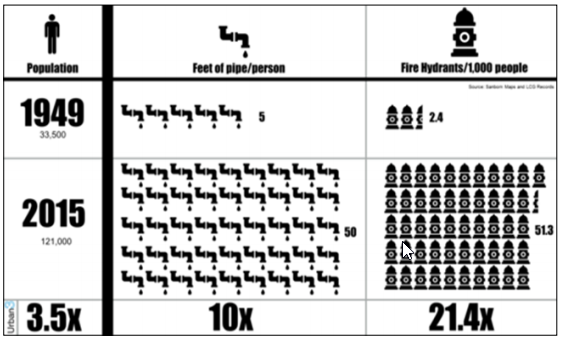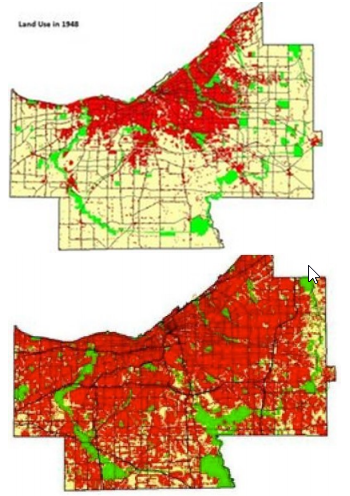Does Your City Have Shiny New Toy Syndrome?
Everybody, at some point, has known (or maybe even been) that kid who just has too many toys. The one who gets showered with new stuff on every special occasion from birthday to Christmas to 100-on-the-spelling-test. And everybody knows the sad, lonely fate of all the older-but-still-fairly-new toys that kid got last year or even last month. Inevitably they’ve gone the way of Woody when Buzz Lightyear arrived on the scene, neglected in some box or closet. Because no matter how many toys you accrue, there are the same number of hours in the day to play with them.

What happens if that kid stops getting any new playthings at all for a year or two? Usually, they figure out how to get more mileage out of the ones they already have. They play-act new stories with that set of dolls or stuffed animals, invent whole worlds for them. They form stronger emotional attachments to their toys, transforming a mildly diverting plaything into the kind of priceless token of childhood that their 40-year-old self will be delighted to pull out of a box and reminisce with.
Adults, of course, have their own versions of Shiny New Toy syndrome: hunger for the new at the expense of cherishing the familiar. I’ve heard it suggested that many of us could challenge ourselves to go a year without acquiring anything new. Re-read the books that shaped your world view; find something new in them. Master that instrument you never had enough time to practice. Tend to your garden.
The discipline of not acquiring more until we’ve wrung true value out of what we already possess can make our lives richer and fuller. And this is a lesson we need to apply to our cities as well.
Our “Shiny New Cities” Habit
Since at least around the middle of the 20th century, the leaders of most North American cities have had Shiny New Toy Syndrome. We have expanded outward at an unprecedented rate, building vastly more roads, pipes, pumps, and power lines than ever before—simply because those things are new, and new growth shows as a big win on the budget sheet.
And it is no coincidence that, in tandem with the onset of this era of shiny-and-new suburban expansion, inner-city neighborhoods across the continent fell into blight and disorder. Jobs vanished. Those who could afford to leave left. Places that had been built with the promise that they would deliver their inhabitants to the American Dream instead left a whole class of Americans shut out of the ability to build inter-generational wealth.
Those who bought suburban homes in this era are no more individually to blame for what is a broader societal failing than the 5-year-old with too many toys is personally culpable for his toy habit. After all, the 5-year-old presumably isn’t the one buying the toys.

It was easier, for a newly emboldened superpower that had just won a world war, to build the shiny and new than to reckon with wringing value out of the old, to do the hard work of weeding our collective garden. Every incentive was lined up in support of this binge on new stuff: federal financing, bank redlining, the scale economies of mass production, and a surge of demand.
And, of course, a colossal campaign of highway spending. Highway construction literally sucks value out of existing developed neighborhoods and transfers it to new, previously undeveloped areas (h/t Angie Schmitt of Streetsblog for tweeting this astute observation).
To understand why this is, think about a metropolitan region as a whole. What sets the limits on that region’s physical growth? You’ve got a certain number of residents (plus new arrivals, and absentee property owners). They have a certain amount of disposable income, and they are willing to spend a certain share of it on real estate. Each variable in that equation is a bit stretchy, but like a rubber band, only to a point.
If I open a restaurant and I’m hugely successful, it’s very unlikely that I’m increasing the total amount that my fellow citizens spend going out to eat by any appreciable amount. It’s far more likely that they’re going to my restaurant instead of another one.
If I’m a mayor and I throw tax incentives at a new mall, it’s unlikely that I’m increasing the total amount spent on clothing and cosmetics and Auntie Anne’s Pretzels by an appreciable amount. It’s far more likely that the old mall down the road is going to suffer a rash of store closures.
If I’m the transportation commissioner and I build a highway, and that highway shortens the commute from Old MacDonald’s farm to downtown Emerald City from 45 minutes to 30 minutes, and that difference makes Old MacDonald’s land way more appealing to a developer, and Old MacDonald sells to the developer and retires to Arizona, and the developer names it MacDonald Glen and puts up 500 beige houses….That chain of events didn’t cause 500 brand new people to want to move to Emerald City.
What happened was that chain of events caused a certain number of people—probably less than 500, but certainly much greater than zero—who were already going to buy a house in Emerald City to buy one out in MacDonald Glen instead of elsewhere in town. And “elsewhere in town” missed out on that activity, like last year’s toy sitting in a box under the bed.
A Practical Limit… But Not Enough of One to Keep Us Out of Trouble
There’s an objection worth answering here. Building more homes and offices and strip malls doesn’t work quite like the parent buying cheap toys for their kid. There’s far more of a practical limit, because a house is a huge investment for the builder as well as the buyer, and if house prices start to fall and you can’t sell new ones at a profit, builders are very quickly going to take the hint. (The toy analogy here, I suppose, would be that the kid literally hasn’t even unwrapped the video game you bought her for her birthday in October, so you’re definitely not buying her another one for Christmas.)

The problem is the market feedback that tells us, “Enough already!” comes too little too late. Or doesn’t hit the people it needs to hit.
This was true for Northeast Ohio, where Jason Segedy describes devastating levels of vacancy in Cleveland, Akron, Canton, and Youngstown neighborhoods, a direct consequence of the region’s building shiny new homes even as its population fell, doubling its physical footprint (and infrastructure obligations) for no net new people over half a century.
When we have that much more stuff than we used to, there’s a strong argument our growth has made us poorer, not richer. The kid with a mountain of toys isn’t happier than the kid with a few cherished ones.
But we’re actually worse off than that kid. Because at least discarded toys don’t come with a permanent maintenance obligation. Roads and sewer pipes, on the other hand, do.
But What If You’re Growing?
Not wanting your kid to have too many toys doesn’t mean you can’t buy them something age appropriate when they’re 12 just because they still have the action figure they liked when they were 8.
I live in a fast-growing suburban county in one of the fastest-growing regions in the country. We’ve added over 7,000 people per year for the last 4 years. So naturally, there’s a lot of development. Let me be clear: If you are adding thousands of people, you should be building thousands of new homes. If you don’t, in fact, you’re going to have huge problems. (Read anything about housing costs in California lately?)
But where are you building them? And who gets to decide?
Historically, all over the world, cities grew incrementally taller and more intense in the center at the same time as they incrementally expanded their footprints outward. Today, we’re all too eager to do only the latter—horizontal expansion—at the expense of letting existing neighborhoods mature. And often it seems driven by the Shiny New Toy Syndrome of a shockingly small number of decision-makers.
To illustrate that, some numbers from where I live: in the rural eastern two-thirds of my county (Sarasota County, FL) there are four large tracts of land—each the size of a small city, each with a single owner, each slated for a huge master-planned development. Together they account for a planned 27,600 homes, mostly single-family houses. The county government’s own population growth projections have us needing 48,621 new housing units between 2020 and 2040. That means a whopping 57% of that growth is accounted for by already-existing plans for currently rural land that’s in the hands of only four owners.
Those 27,600 planned houses, and the decisions of those four owners and a handful of local officials, threaten other priorities that the public might well care about. They threaten our financial solvency, because they’re going to require a lot of new roads, instead of using infrastructure that already exists.
They threaten the stability of our existing neighborhoods. Our cities are full of neighborhoods with aging homes that need some TLC. They’re a bit dated, but still perfectly serviceable and in attractive areas that don’t inexorably have to tip into decline. But some of them are going to tip into decline, as long as that giant sucking sound of edge growth continues.
They threaten our ability to house our growing senior citizen population in existing walkable neighborhoods where they can age in place and retain some independence.
They threaten our environment. People where I live drive more annual miles per capita than in 95% of U.S. metro areas, and it’ll be hard to reduce that statistic (and associated fossil-fuel emissions) if over half of all new homes are built on the outer fringe of the region.
Shiny New Toy Syndrome threatens our future.
Let’s Cherish What We Have, and Build Only What We Need.
We’ve had decades of unproductive growth. We need productive growth, the kind that makes better use of investments we’ve already put in the ground. We need to make existing neighborhoods richer, to thicken them up not just with development, but also with life and creative energy and opportunity.
This is not an argument against the construction of new homes and offices and retail spaces: anywhere the population is growing, we are going to be doing that. If you are going to have 10,000 new people in five years, you should expect to have homes for 10,000 new people in five years. But it matters where those homes go.
Shiny and new costs us more than we can calculate. Adding value and people and stories and love to places that are already inhabited and loved by someone, on the other hand, is like picking up a favorite old toy and enjoying it anew.

Daniel Herriges (Twitter: @DanielStrTowns) serves as Content Manager for Strong Towns and has been a regular contributor since 2015. He is also a founding member of the organization. Daniel has a Masters in Urban and Regional Planning from the University of Minnesota. His love of great urban design and human-scaled, livable places has also been lifelong. Daniel has a B.A. from Stanford University in Human Biology with a concentration in Conservation and Sustainable Development. Daniel is from St. Paul, Minnesota.
https://www.strongtowns.org/journal?author=54d91114e4b0740a2a5058d4


Advertisement